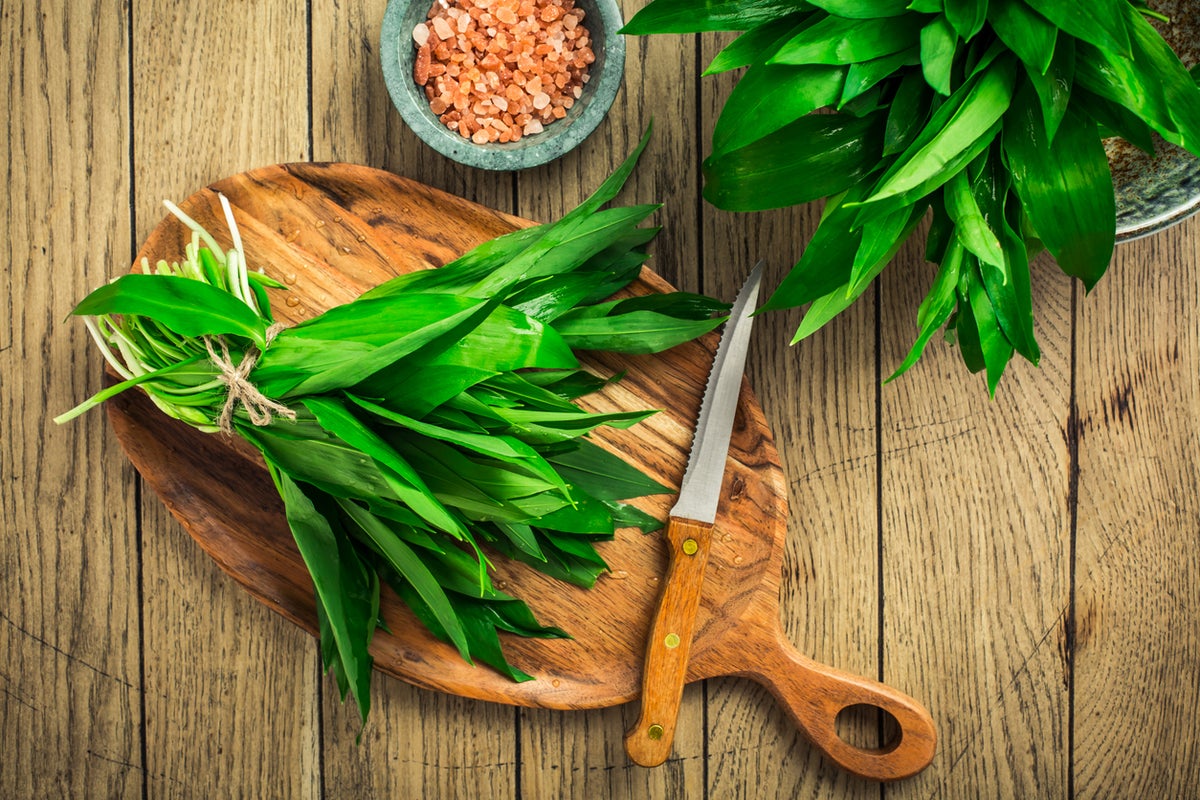
Every spring, it starts again. The white blooms creep out from shaded woodland floors, the scent hits your nose before your eyes have had a chance to adjust to the dappled light, and suddenly it’s everywhere. Wild garlic season.
Menus across the country sprout with it. Pesto, butter, mayonnaise, oil. Paired with burrata, folded into duxelles, spooned onto eggs, swirled through soup.
Every year, like clockwork, chefs lose their minds. “We make sure wild garlic appears on our menu every spring to celebrate its return,” says Clare Coghill of Café Cùil on the Isle of Skye. “It holds huge sentimental value to me from picking it as a child with my mum on spring walks by the shore.”
The question is: what are the rest of us meant to do with it? For something that’s become such a seasonal signifier, wild garlic still feels surprisingly elusive for home cooks.
You might recognise it by scent. You might spot it on a menu. But do you know what to do with it beyond blitzing it into pesto?
Let’s fix that.
So what actually is wild garlic?
Also known as ramsons, bear’s garlic or allium ursinum, wild garlic grows abundantly in damp, shaded woodland from March to early May. Its long, flat leaves and star-like white flowers are as photogenic as they are pungent. But despite the name, its flavour isn’t quite the same as the garlic bulb we know and love. It’s fresher. Lighter. Gentler.
“Wild garlic has a recognisable garlic flavour, but with a more earthy, gentle twist,” says Amy Elles of Stocks Kitchen in Kinross. “It’s less sharp than cultivated garlic, offering a fresher, subtler taste. This makes it perfect for adding depth to a variety of dishes.” Alan Keery of Nàdair in Edinburgh agrees, calling it “a much more rounded garlicky flavour”. It also “has a slight sweetness and minerality to it … Despite its pungency, wild garlic has a nice aroma to it and mellows out when cooked.”
Niall Munro of Birch Coffee in Fort William gets straight to the point: “It tastes like garlic and spinach had a baby.”
Why chefs go mad for it
Wild garlic is one of the UK’s great seasonal flexes. It’s free, it’s fragrant and it’s fleeting. “It’s the time of year it comes at,” says Keery. “After months of bleakness and miserable weather, the first signs of wild garlic give relief for warmer climes ahead.” For chefs, it’s a creative reset button. For diners, it’s a promise: spring is coming.

“It marks the beginning of all the good things to come,” adds Elles. “It’s like a breath of fresh air during the hunger gap, bringing excitement and flavour to the season.”
And yes, there’s a bit of chef posturing, too. Wild garlic’s brief season and foraged exclusivity make it perfect for specials boards and Instagram stories. But that doesn’t mean it’s just for show. “The joy of wild garlic is its full-on flavour,” says Keery. “Don’t be shy with it – eat it with gusto.”
The pesto problem
Pesto is the gateway drug. Everyone makes it. Everyone loves it. It’s easy, familiar and requires no cooking – which is ideal, as cooking wild garlic too much can destroy both its colour and flavour. “If you’re cooking the wild garlic in heat – ie into a soup or sauce – you can cook it for too long, which loses its flavour and vibrant colour,” warns Coghill. “My best advice is to use it raw for best results.”
But here’s the thing: it doesn’t have to only be pesto. “Wild garlic can definitely take centre stage if you want it to,” says Elles. “Like in wild garlic soup or a wild garlic frittata. It’s all about balance, though, since its garlic flavour can be quite strong – you don’t want to overdo it. There aren’t any hard and fast rules with wild garlic – experiment and find what works for you at home.”
So what can I actually do with it?
Glad you asked. The beauty of wild garlic is its versatility. The chefs we spoke to use it in butters, oils, chimichurri, mayonnaise, vinegars, ferments, tortillas and more.
“Use wild garlic in any situation that calls for regular garlic,” says Henry Dobson of Moss in Edinburgh. “It’s super versatile! It’s a welcome addition to leaf salads, it’s fantastic blended into dressings, cut into chiffonades and sauteed in butter as a base for a sauce. Simply substitute regular garlic for wild garlic and see how you get on.”
Elles goes further: “Wild garlic mayonnaise goes with just about anything! It’s perfect with cooked prawns, ham, frittatas, tortillas, jacket potatoes, or inside any sandwich. It’s also great with egg mayo, cold rare roast beef, sausages, roast vegetables, lamb koftas – there are no limits.”
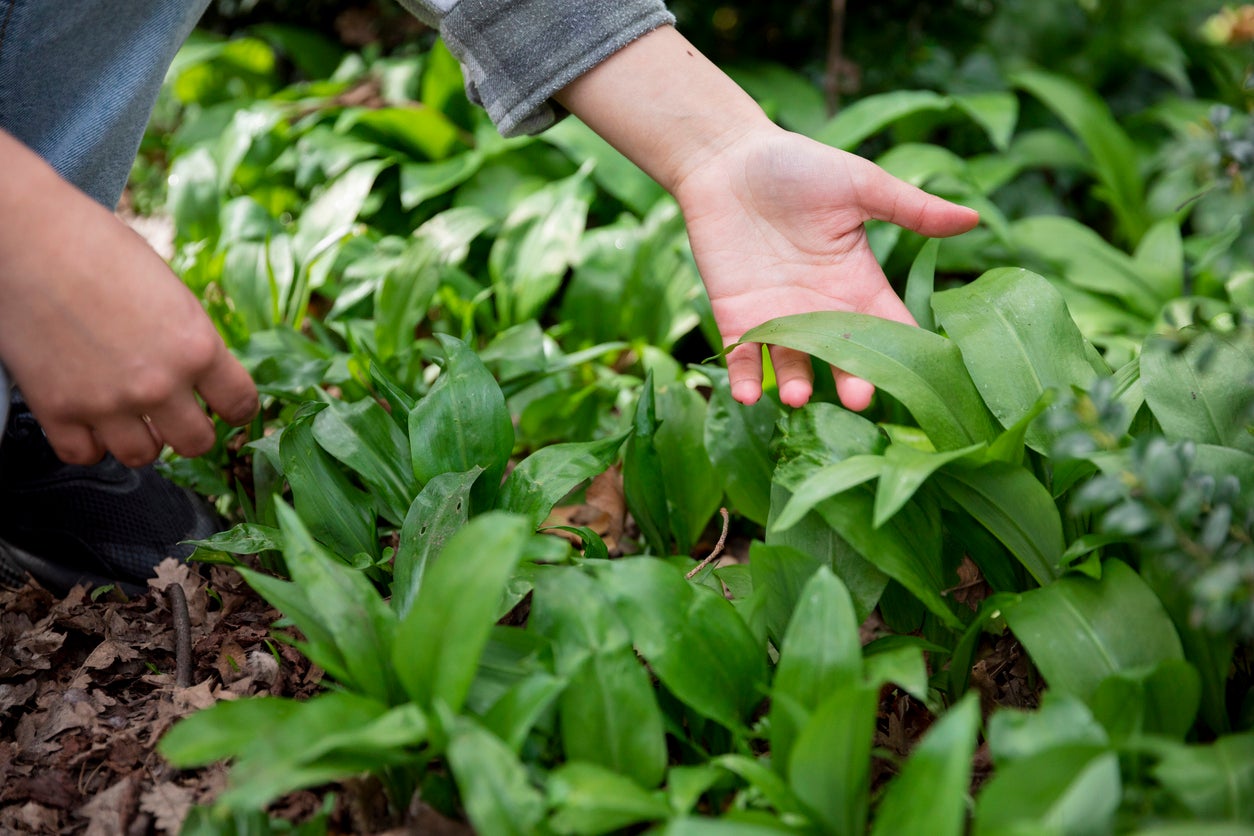
Dobson also points out its preserving potential: “You can also infuse oils and vinegars with it, dehydrate it and make salts with it or even use it to make kimchi paste.”
Keery adds: “I infuse it into vinegar for a base for dressings, or make big batches of wild garlic butter to have on hand in the fridge. It’s great for tossing through pasta or cous cous or simply wilted to serve with asparagus or sauté potatoes.”
And when the season peaks? “I like to make butter with excess wild garlic,” Keery continues. “It keeps for ages in the fridge and is great for cooking steak, tossing through freshly cooked pasta or roasting chicken. All you do is melt some butter, let it cool slightly and either chop some wild garlic to mix through or blitz the two together in a blender.”
At Café Cùil, Coghill pairs wild garlic pesto with burrata and stewed venison chorizo on toast. “The punchy flavour of the tomatoes and chorizo cuts through the creamy burrata, then the zesty wild garlic pesto on top elevates the dish to make a perfect brunch combo,” she says. Her secret? Taste regularly and use the highest quality of produce possible. At Nàdair, Keery serves gnocchi fried in wild garlic butter, wilted wild garlic leaves and “lashings of cheese”.
Munro offers a vibrant spring brunch dish: smoked cheddar scrambled eggs on sourdough, topped with wild garlic duxelles, capers and chive oil. Elles keeps it elegant with wild garlic mayonnaise served alongside blanched asparagus and radishes. Calum Munro of Scorrybreac, meanwhile, makes a Scottish tortilla using mashed potatoes and blue corn flour, layering it with mushroom duxelles and wild garlic pesto.

Want to keep the flavour going? Ferment it. “Fermenting wild garlic is my favourite way to store it,” says Dobson. “Simply macerate with salt, seal in an anaerobic environment and age until fermented. Then store in the fridge (almost) indefinitely.”
Foraging? Read this first
Wild garlic is easy to identify – and easy to mistake. “It’s always tempting to stop and pick a few, but be careful not to confuse it with the poisonous lily of the valley,” warns Elles, “which doesn’t smell like garlic and only has two leaves sprouting from a shoot, unlike wild garlic, which has many.”
Look for it in damp, shady woodlands, often near water. “You’ll smell it before you see it,” says Coghill. “When it’s in full bloom, you’ll see beautiful white flowers shooting out from the green.”
And forage responsibly. “Always take just a few leaves from each plant to ensure it keeps growing,” says Elles. “Never dig up the roots, or it won’t grow back.”
Mistakes to avoid
Beyond the obvious plant ID errors, the biggest mistake? Being too timid. “People don’t use enough of it because they’re a tad nervous of it being overpowering,” says Keery. “They’ll maybe add a small touch here or there but don’t get the full shebang.”
Also: store it properly. “Keep it chilled in the fridge and it’ll last a few days,” says Munro. “If left at room temperature or warmer, it’ll wilt quite quickly. The buds that grow before flowering are great for pickling, if you want to preserve it for later.” Want to keep it longer? Blanche and freeze it like spinach, or preserve it in pesto, butter or mayo.
And use a sharp knife. “Using a dull one can bruise the leaves, which affects the taste and makes them less appealing to eat,” says Elles. “A clean cut keeps the flavour fresh and the leaves looking their best.”
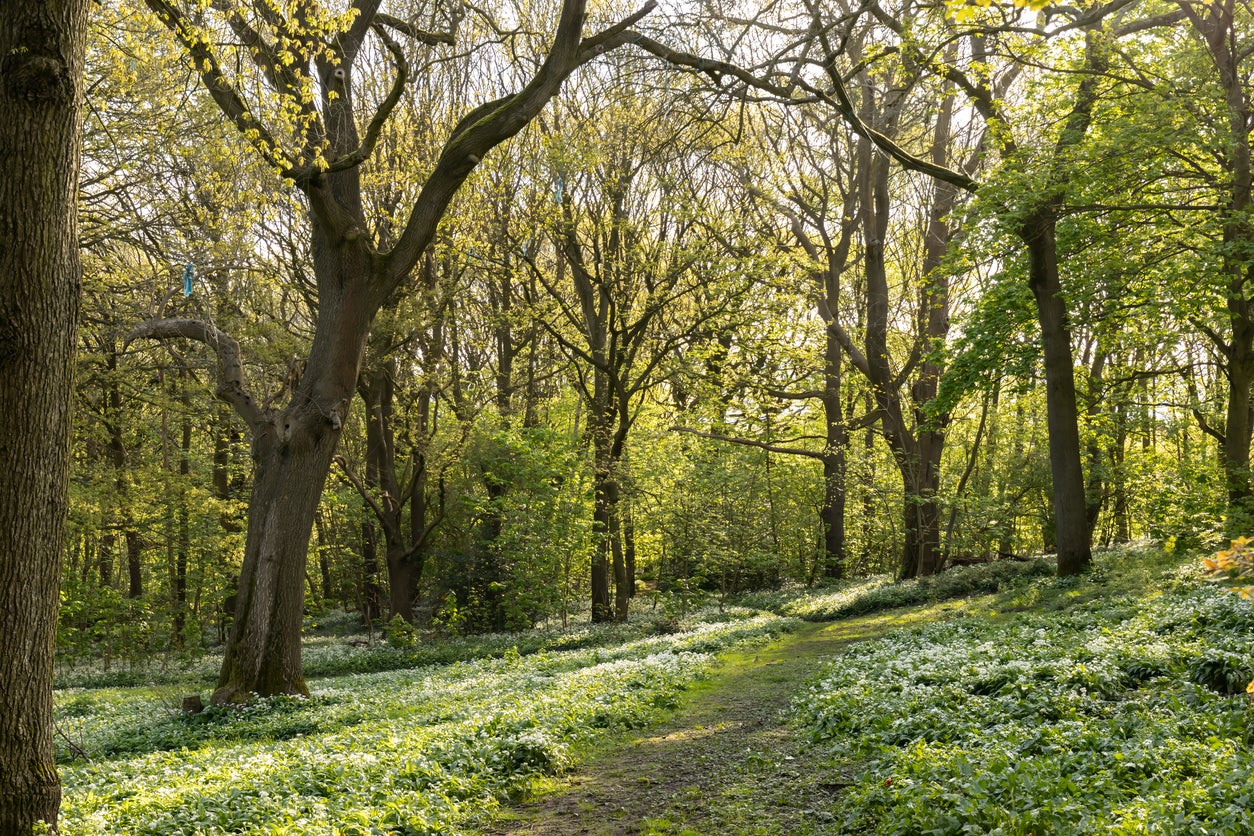
And if I miss the season?
There’s no true substitute, say the chefs. “No!” exclaims Keery, when I ask. “I guess maybe crow garlic [better in late winter and early spring] but it doesn’t have that wonderful pungency that wild garlic has.”
Others are more pragmatic. “Regular garlic, leeks and spring onions are all good substitutes,” says Munro, while Dobson suggests visiting a market garden for garlic chives or baby leeks once the wild stuff has faded.
“Although a different flavour profile, wild sorrel is an excellent alternative if you’re looking for a punchy green herb that grows in abundance all year round,” adds Coghill.
Elles points to other foraged friends: “Alongside wild garlic, you have spring nettles and Alexander’s and jack by the hedge, which also arrive around the same time, offering plenty of alternatives and great additions to your dishes.”
And if you do get your hands on the flowers? “The wild garlic flowers are so pretty and make the perfect garnish for salads or mains,” she says.
Wild garlic is trending for a reason
Yes, it’s all over your Instagram feed. Yes, chefs get excited about it every single year. But that’s because it deserves the hype. It’s flavourful, free (if you’re willing to bend down) and wildly versatile.
It’s also a gateway to more seasonal cooking. “Eating seasonally makes family meals more fun and interesting,” says Elles, who regularly takes schoolchildren foraging. “If kids are involved in foraging and cooking, they’re much more likely to try new and unusual foods.”
So this year, instead of skimming over it on menus or scrolling past another chef’s bright green butter, pick some up. Try a tortilla. Ferment a jar. Make a big, loud brunch dish with cheese and eggs and leaves and pride.
Because yes, wild garlic is trendy. But it’s not just for chefs.
Fermented wild garlic
By: Henry Dobson, Moss, Edinburgh
Ingredients:
Freshly gathered wild garlic
2% of the wild garlics weight in salt
Method:
1. Firstly, weigh your wild garlic and calculate 2% of its weight. This is the amount of salt you need to add.
2. In a bowl, knead the salt into the wild garlic until moisture has been released and the texture of the wild garlic resembles that of wilted spinach.
3. Then stuff the wild garlic into a sterilised kilner jar, ensuring that the liquid covers the top of the wild garlic. You can use an appropriate weight such as a stone or a small jam jar filled with water to weigh everything down. Close the lid of the killer jar and leave at room temperature.
4. Check on the jar once a day, popping the lid periodically to release any gasses. After two or three days you will notice bubbling! Once bubbling subsides and the garlic has taken on a little sourness and a bit of pleasant complexity (5-10 days depending on conditions), move the jar to the fridge and store for up to a year. Periodically ensure that liquid is covering the wild garlic to prevent spoilage. If your ferment is dry, top up with a 2% salt and water brine solution.
Note: The ferment can be consumed immediately but will continue to develop in the fridge. It will hit its peak after around 6 months in the fridge and will continue to be perfectly edible for many months after that.
Potato tortilla with mushroom duxelles with wild garlic and wild garlic pesto
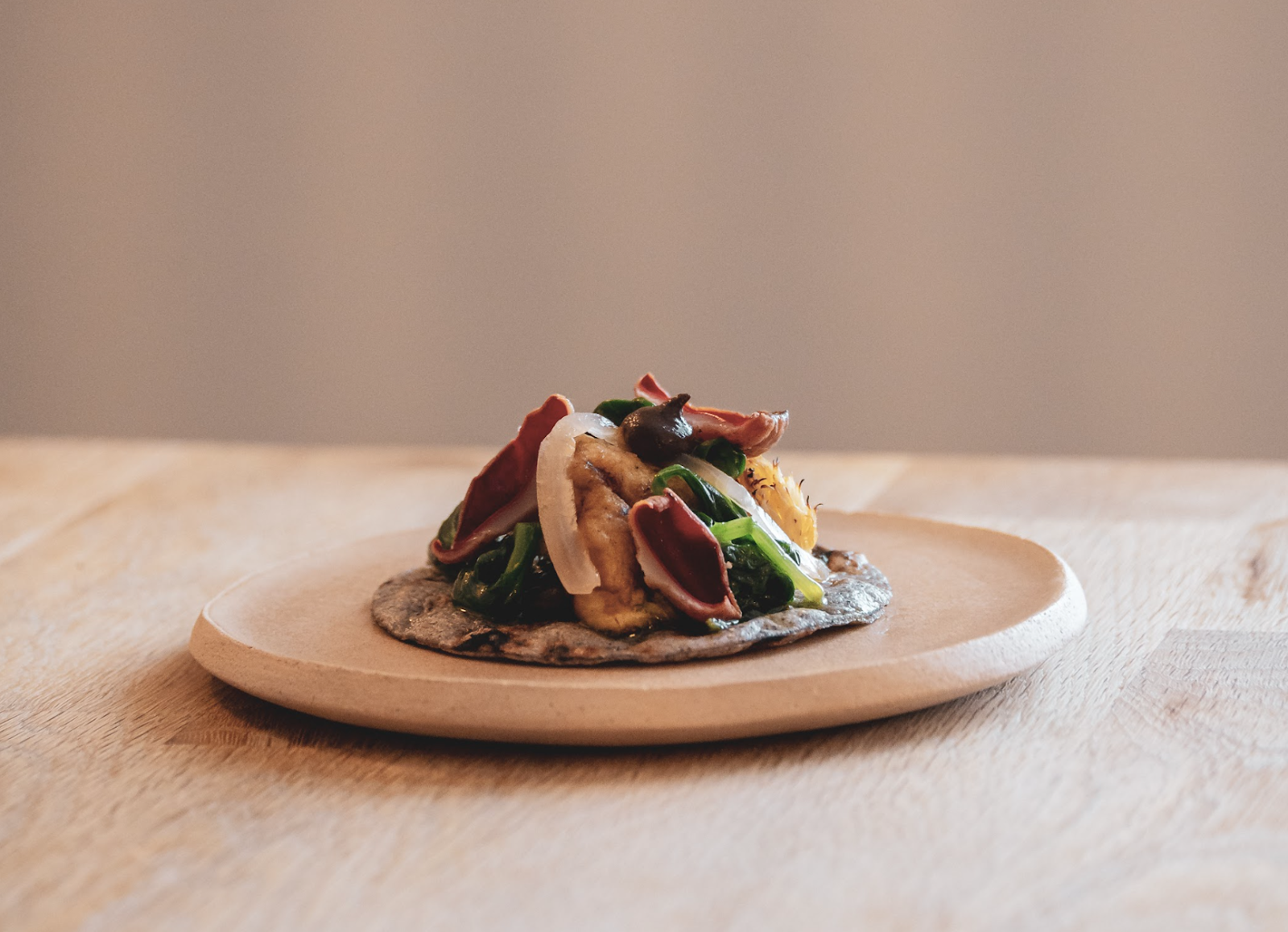
By: Calum Munro
“This is a great wee Scottish take on a tortilla. I use potato instead of water as I prefer the texture and the flavour, plus it reminds me of a traditional Scottish tattie scone!”
Serves: 4
Ingredients:
For the tortilla:
200g mash potato
100g blue corn flour
Salt
For the mushroom duxelles:
400g mushrooms of your choice
½ shallot
Handful of wild garlic leaves
30ml dark soy
For the wild garlic pesto:
25g wild garlic
100g Kale
35ml white wine vinegar
2 tbsp Dijon mustard
100g cashew nuts
200ml chilled olive oill
4 egg yolks
1tsp sugar
Method:
To make the mushroom duxelles:
1. Dice up your shallot as finely as you can. In a food processor, blend with your mushrooms until they are a paste.
2. Add in your soy and wild garlic at the end, then in a nonstick pan sauté the mix until most of the moisture has evaporated. Set aside ready for use.
To make the pesto:
3. In a food processor add the yolks, mustard, vinegar and sugar, mix for a minute then add in the cashews and wild garlic and then kale. You might need to stop and scrape down the sides of the processor.
4. Then slowly add in your olive oil emulsifying. Check the seasoning. Fridge ready for use.
To make the tortillas:
4. Combine the cold mash and corn flour, mixing until it forms a dough.
5. Portion them into balls of around 25g. Then either using a rolling pin or tortilla press, roll them out between parchment paper.
6. They can be toasted in a hot dry pan, then set aside for use later. I finish them on a BBQ, you can do over a gas hob if you are feeling adventurous!
7. To serve, reheat the tortilla then spread the duxelle paste on. If you wish to add a bit extra like meat or veg add this before putting the pesto on top
.jpeg)
By: Clare Coghill, Café Cùil, Isle of Skye
“We make sure wild garlic appears on our menu every spring to celebrate its return every year. It also holds huge sentimental value to me from picking it as a child and learning to identify it with my mum on spring walks by the shore. We currently have a wild garlic pesto on our menu paired with fresh burrata and stewed Scottish chorizo. It has a vibrant green colour which is excellent for making flavourful pesto. You can also use it in soups or dice it through a salad.”
Serves: 1
Ingredients:
For the wild garlic pesto:
1 handful wild garlic (rinsed)
100g pine nuts
100ml extra virgin olive oil
1 handful fresh parsley leaves
½ lemon (juice only)
1 tsp sea salt
For the rest of the dish:
1 punnet of cherry tomatoes (cut in half)
100g great glen venison chorizo (diced)
100g regular cooking chorizo (diced)
1 tsp fennel seeds
4 tbsp olive oil
1 red onion (diced)
2 tbsp water
1 tsp paprika
Sea salt
Black pepper
1 burrata
1 slice sourdough (toasted)
Method:
To make the wild garlic pesto:
1. Begin by rinsing the freshly picked wild garlic under cold water, making sure you get rid of any soil from outside. Place the wild garlic onto a clean chopping board and dice it into pieces to make it easier to blend.
2. Pick the parsley leaves off the stem, and add them into a blender along with the chopped wild garlic and the extra virgin olive oil.
3. Whizz the wild garlic, parsley and oil together until you have a vibrant green oil. Stop the blender and add in the pine nuts, lemon juice and sea salt, before pulsing again until the pine nuts break down.
To make the chorizo burrata toast:
4. Begin by sweating off your onions and fennel seeds in 1 tbsp olive oil until they begin to soften and sizzle.
5. Add in the diced chorizo and paprika, and allow the chorizo to sweat off and release its flavour into the pan, this should take about 2-3 minutes.
6. Once the chorizo has a bit of colour on it and the onions have turned red, add in your cherry tomatoes along with the water and olive oil, and allow the tomatoes to break down into the sauce.
7. Let the stew bubble on the heat for 5 minutes until all of the flavours have combined.
8. To serve, toast your sourdough and place it onto a plate, then spread your burrata onto the toast with a general scattering of cracked pepper and olive oil.
9. Ladle a helpful portion of stewed chorizo on top of the burrata, followed by the vibrant wild garlic pesto.
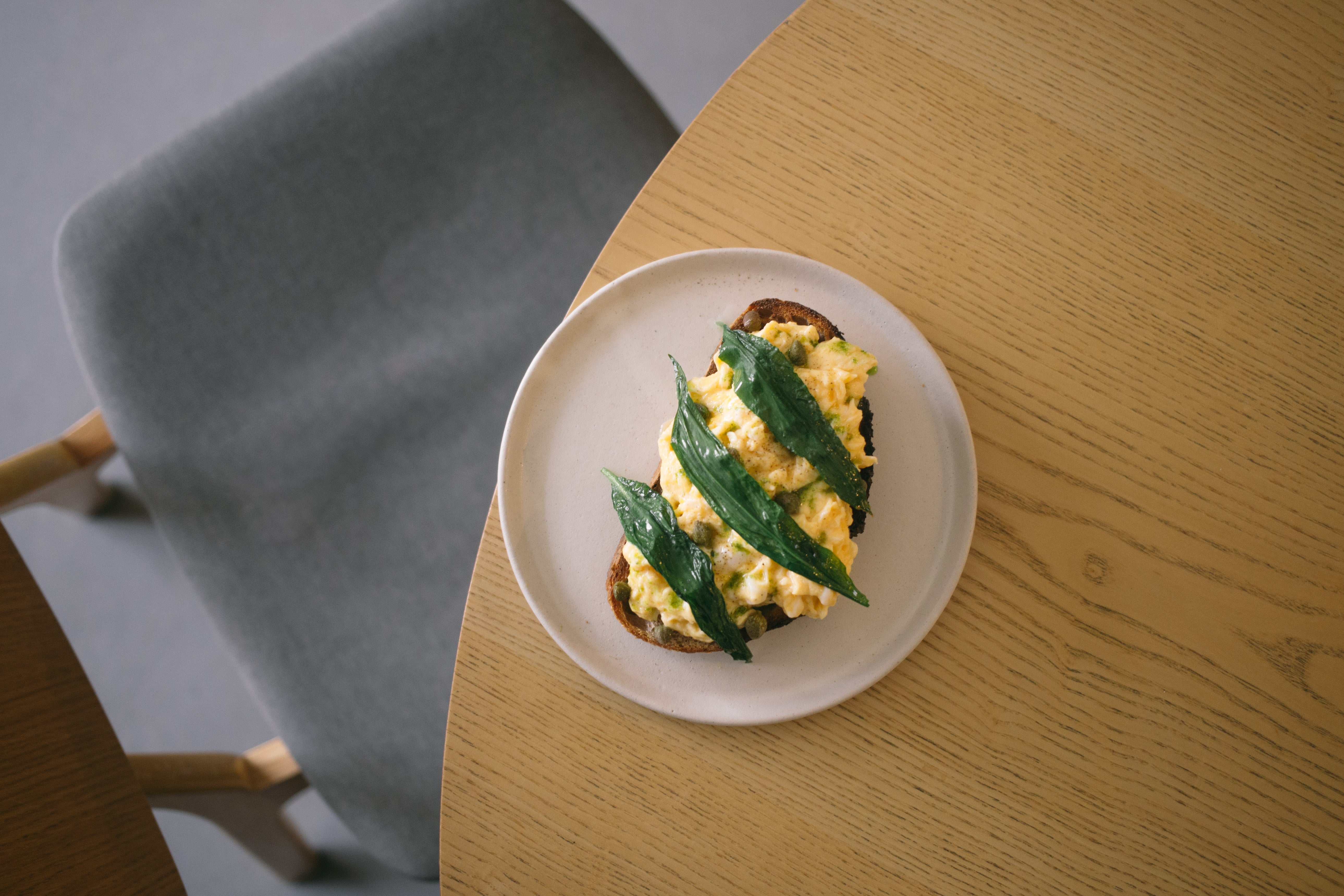
By: Niall Munro, Birch Coffee, Fort William
“This is the perfect brunch dish to welcome in the spring, offering a vibrant twist on your classic egg and mushroom combo. The mushroom duxelles and smoked cheddar creates a real, rich umami, with foraged wild garlic cutting through with a punch of freshness.
“Wild garlic is available in abundance across Scotland at this time of year, and can be easily foraged – even by beginners – due to its unmistakable onion-y smell. Keep an eye out for it in sheltered woodland areas by shores or streams.”
Serves: 1 (vegetarian friendly)
Ingredients:
For the chive oil:
Small bunch of chives
200ml extra virgin olive oil
Pinch of salt
For the mushroom duxelles:
200g mushrooms of choice (finely diced)
6 wild garlic leaves (roughly chopped)
1 shallot (finely diced)
1 tsp neutral oil
Salt and pepper to taste
For the scrambled eggs:
3 eggs
20g smoked cheddar
1 tbsp butter
Salt and pepper to taste
To finish:
3 wild garlic leaves
1 slice of sourdough bread (toasted)
1 tsp capers
Salt and pepper to taste
Method:
To make the chive oil:
1. Blitz up chives, olive oil and a pinch of salt in a blender until fully incorporated.
2. Strain and store in a bottle or jar.
To make the mushroom duxelles:
3. Heat up the oil in a frying pan on a medium heat and add in your shallots. Sweat off until the shallots become translucent.
4. Blitz 200g of mushrooms in a food processor, or finely dice, and add into the pan with the shallots, wild garlic and a pinch of salt. Cook down the mushrooms until all of their moisture has fully evaporated. Season with salt and pepper to taste.
To make the scrambled eggs:
5. Crack your eggs into a bowl and whisk up with your smoked cheddar and a pinch of salt.
6. Add butter to a pan on a high heat. Once fully melted, add in your scrambled eggs.
7. Scramble continuously on a high heat for 10-20 seconds until just cooked – velvety but not completely firm.
To finish:
8. Blanch three wild garlic leaves in a bowl of freshly boiled water for 5-10 seconds. Remove and place on a paper towel to dry.
9. Spread your mushroom duxelles over a slice of toasted sourdough and top with your scrambled eggs.
10. Top the scrambled eggs with capers, your blanched wild garlic leaves and a drizzle of chive oil.
11. Season with salt and pepper to taste.
.jpeg)
By: Amy Elles, Stocks Kitchen, Kinross
“I use wild garlic in so many ways – batch-cooked pesto (which the kids love) and soup are particular favourites. We’re fortunate to have a few great patches of wild garlic nearby, and I often take the local school and nursery kids out to forage. We cook soup right there in the woods, offering them a wonderful, hands-on way to explore food, flavours and the confidence to be adventurous in the kitchen. One of my favourite culinary rituals is the pre-dinner nibbles – the things you eat just before the meal begins. It’s like the opening act of a play, setting the stage for the delicious journey ahead.
“When spring is in full swing, asparagus, radishes and wild garlic are at their best. These seasonal ingredients are not only abundant but also incredibly versatile. Paired with a glass of wine, they offer the promise of something even more delicious to come.
“For this recipe, I’ve used a pestle and mortar to bring everything together, but if you don’t have one, a blender will do the trick just as well.”
Serves: 2 as a starter
Ingredients:
1 bunch asparagus
1 bunch fresh radishes
10 fresh garlic leaves (washed and roughly chopped, approx 25g)
1 egg yolk
1 heaped tsp Dijon mustard
125ml vegetable oil
50ml extra virgin olive oil
Juice of ½ a lemon
Pinch of salt
Method:
To make the garlic paste:
1. In a pestle and mortar, combine the garlic leaves and a pinch of salt. Grind until the garlic forms a paste, then set aside.
To make the mayonnaise:
2. Place a medium-sized bowl in a saucepan with a tea towel underneath to prevent it from sliding around. Add the egg yolk, Dijon mustard and a pinch of salt to the bowl. Whisk until fully combined.
3. Gradually add the vegetable oil while whisking constantly. Once the emulsion starts to form, you can add the oil a little faster. After incorporating half of the oil, squeeze in the lemon juice, then continue adding the rest of the oil.
4. Taste and adjust the seasoning with more salt or lemon juice if needed.
5. Stir in the garlic paste, mixing until well combined. Transfer the mayonnaise to a bowl for serving.
6. Blanch the asparagus
7. Bring a pot of salted water to a boil. Blanch the asparagus for 3-4 minutes until just tender. Drain and serve with the wild garlic mayonnaise and sliced radishes on the side.
.jpeg)
By: Alan Keery, Nàdair, Edinburgh
“I’ve a soft spot for this dish as we always serve it at the beginning of spring and it’s a reminder of warmer days to come. It’s very important to not undercook the carrots or else you won’t extract their beautiful sweetness. Wild garlic grows in abundance in Scotland this time of year, but if you don’t fancy foraging for your own, farmers markets or delicatessens are a good source.”
Serves: 4 as a starter
Ingredients:
2 bunches baby rainbow carrots
1 sprig thyme
10g root ginger, sliced
300g full fat yoghurt
100g plain granola mix
150g of garlic leaves
100ml vegetable oil
5g pink peppercorns
Salt
Method:
To make the labneh (prep the night before):
1. Whisk a pinch of salt into the yoghurt.
2. Line a colander with cheesecloth and place a bowl underneath. Pour the yoghurt into the colander and leave in the fridge to strain overnight.
To make the wild garlic oil:
3. Blitz up 100g of your wild garlic leaves in a blender with 100 ml of vegetable oil.
4. Strain well and store in a jar or bottle.
To make the carrots:
5. Take the strained yoghurt (labneh) out of the fridge and collect the whey from the bowl.
6. Add the whey to a baking tray with the carrots, thyme and ginger and season with salt.
7. Cover with tin foil and cook at 180C until the carrots start to soften.
8. Whilst the carrots are cooking, lightly crush the pink peppercorns and toast in a pan. Add the toasted peppercorns to the granola and mix well.
9. When the carrots are ready, take them out of the oven and, with the heat of the baking tray, wilt the wild garlic leaves. Discard the ginger and thyme.
To serve:
10. Place a generous dollop of the labneh into a bowl. Arrange the carrots and wild garlic around it.
11. Top with the granola and drizzle with your wild garlic oil.







